Canis Major Constellation aka The Greater Dog
Canis Major means “greater dog” in Latin. We can easily identify the Canis Major constellation because of the super-bright star Sirius. Its famous form has been recognized all over the world since ancient times. Claudius Ptolemy included it in the Almagest as one of his 48 constellations.
The International Astronomical Union (IAU) recognizes Canis Major as one of the 88 modern constellations. It is enclosed in a quadrilateral or a four-sided polygon. With an area of 380 square degrees, it ranks as the 43rd largest constellation of today. Unlike other famous constellations, no meteor shower is related to Canis Major.

In addition to Sirius, the Greater Dog has many other interesting stars like the red hypergiant VY Canis Majoris and the Wolf-Rayet star EZ Canis Majoris. The Milky Way passes through Canis Major. Because of that, there are lots of interesting deep-sky objects in this constellation, especially open clusters. Other deep-sky objects include Thor’s Helmet Nebula, the Canis Major Dwarf Galaxy, and a pair of colliding spiral galaxies, among others.
Canis Major belongs to the Orion family of constellations. There are five members of this group, four of which have a common Greek story, except the unicorn constellation.
- Orion (the Hunter)
- Canis Major (the Greater Dog)
- Canis Minor (the Lesser Dog)
- Lepus (the Hare)
- Monoceros (the Unicorn)
What Does Canis Major Look Like?
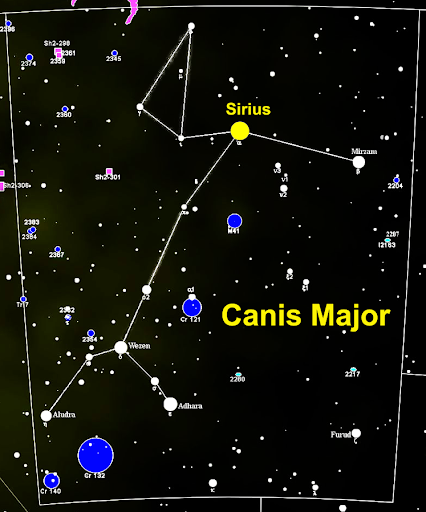

The area that Canis Major occupies in the night sky is enclosed by a quadrilateral. This official boundary was set in 1930 by the astronomer Eugène Delporte.
While there is no official constellation pattern, the most famous form of the Great Dog is outlined by its prominent stars. The bright star Sirius (Alpha Canis Majoris) is the point below the dog’s neck while Mirzam (Beta Canis Majoris) is one of its front legs. The three stars above Sirius forms a triangle that becomes the celestial dog’s head.
The dog’s hind part can be formed by connecting the stars Wezen (Delta Canis Majoris) and Adhara (Epsilon Canis Majoris). The supergiant star Aludra (Eta Canis Majoris) can be interpreted as the dog’s tail.
The Dog Constellations



There are three dog constellations in our night sky: Canis Major, Canis Minor, and Canes Venatici. Canis Major and Canis Minor are intertwined together in a Greek tale together with Orion the Hunter.
The other dog constellation, Canes Venatici lies in the northern sky. It is represented by two dogs, known as the “hunting dogs” of the farmer Boötes in Greek mythology.
Where To See the Canis Major Constellation
Canis Major, or the Greater Dog, lies in the southern celestial hemisphere. Specifically, it is in the second quadrant of the southern sky (SQ2). Its right ascension is 06h 12.5m to 07h 27.5m, with a declination of −11.03° to −33.25°.
Observers from around the latitudes +60o and -90o can see the Greater Dog. It indicates that this constellation is visible throughout the southern sky because of its southern declination.
Canis Major and Its Neighbors

Canis Major is a mid-size constellation that occupies 0.921% of the sky. It is surrounded by four other constellations which we can use as guides to spot it.
To its north is Monoceros the Unicorn, to the east and southeast is the Poop Deck constellation, Puppis. Columba the Dove is in its southwest area while Lepus the Hare surrounds it to the west.
How to Spot Canis Major
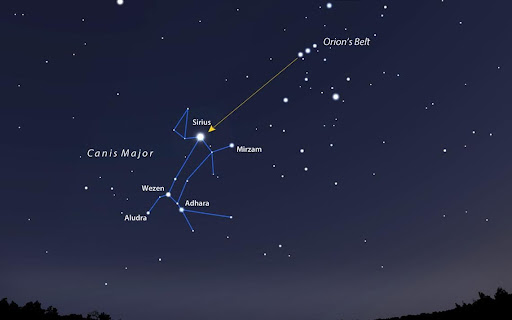
Orion is arguably the easiest constellation to spot. Since Canis Major chases after the celestial hunter in the night sky, we can use Orion’s Belt to find the big dog.
First, we have to look for the asterism or pattern of Orion’s Belt. It is made up of three stars, Alnitak, Alnilam, and Mintaka. These stars form a diagonal line. If we try to draw an imaginary line connecting the three and extend it to Alnitak’s side, the line will point us to Sirius!
When To See the Canis Major Constellation
Canis Major is a seasonal constellation in the northern celestial hemisphere. We can only see it during certain times of the year, unlike circumpolar constellations.
It is seen during the winter months in the northern hemisphere, from December to February. However, the best time to see it is in February at 9 pm. During that time, it is summer in the southern hemisphere.
The Winter Triangle

The Winter Triangle is an asterism, not a constellation. We can form it by connecting the three bright stars Sirius, Betelgeuse, and Procyon. These stars are from three different constellations, Canis Major, Orion, and Canis Minor, respectively.
As the name says, this asterism can be seen best by northern sky observers during winter. We can see the other bright stars of winter near this triangle like Aldebaran (Taurus), Capella (Auriga), Castor (Gemini), and others.
This pattern is also seen in the southern sky around the same time when it is summer there. But unlike in northern latitudes, it appears upside down in the southern sky.
The Winter Hexagon
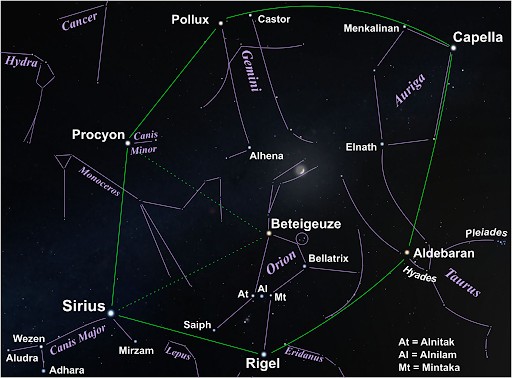
The Winter Hexagon is an asterism just like the Winter Triangle. It is also called Winter Circle or Winter Oval. We can form it by connecting the stars Sirius (Canis Major), Rigel (Orion), Aldebaran (Taurus), Capella (Auriga), Pollux (Gemini), and Procyon (Canis Minor). The Winter Triangle is inside this hexagon.
Canis Major and Its Stars
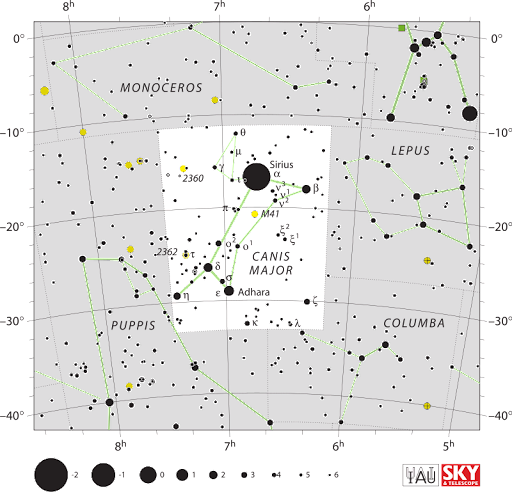
Canis Major has a lot of bright stars. In particular, five stars are brighter than the third magnitude. More than five stars in this constellation were given names by the IAU. These stars are Sirius, Adhara, Wezen, Mirzam, Aludra, Furud, Amadioha and Muliphein. Some of the stars of the Greater Dog have planets surrounding them.
Interestingly, it is believed that the star Adhara was the brightest in the night sky 4.7 million years ago. Mirzam is also thought to have dominated the sky 4.42 million years in the past. About 2.87 million years in the future, the star NR Canis Majoris will also take over. By that time, its magnitude will be around −0.88.
Let’s get to know the notable stars of Canis Major.
Sirius (α Canis Majoris)

Sirius is known as the “Dog Star.” With an apparent magnitude of -1.46, it is the brightest star in the Canis Major constellation and the night sky as a whole. In ancient times, hot summer days were called “dog days” due to the rising of this star.
Even its name speaks of its brightness as its name is from the Greek word Seirios which means “glowing” or “scorching.” It is two times as bright as the second brightest star in our night sky, Canopus.
Sirius looks very bright here on Earth because it is a close neighbor of our solar system. It lies just 2.64 parsecs or 8.6 light-years away. Its important to note that it is a binary star. It is composed of Sirius A, a main-sequence star, and a white dwarf known as Sirius B.
The individual stars are roughly 20 AU apart. They orbit each other in 50 years. This star system is roughly 230 million years old.
-
Sirius A
Sirius A is the primary star in the system. It is a main-sequence star with a stellar classification of A0mA1 Va. It is twice as massive as the Sun. This star has an apparent magnitude of −1.47, with a surface temperature that is around 9,940 K.
This Am star has heavy elements on its surface like iron. This high metallicity is probably influenced by its companion star Sirius B. It will take a billion years for Sirius A to exhaust the hydrogen in its core and turn into a red giant.
-
Sirius B
Sirius B is sometimes called “the Pup” as it is the smaller companion in the system. It is much lesser in terms of brightness as its apparent magnitude is only 8.44.
Looking at the evolution of the system, it was found out that Sirius B was once the more massive star when it was still in the main sequence. Now, it has become a white dwarf star with the stellar classification of DA2. At 1.02 solar masses, this is one is considered very massive for a white star.
Mirzam (β Canis Majoris)
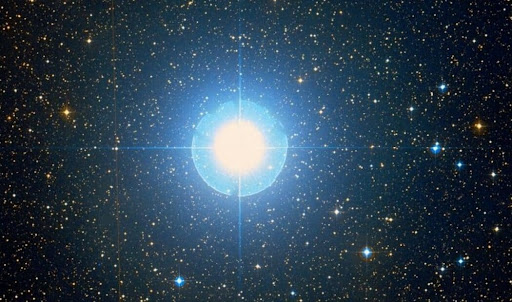
Mirzam is a Beta Cephei variable star with the stellar class B1 II-III. The spectrum tells us that it shows characteristics of both a giant and a bright giant star.
Beta Canis Majoris, as it is called in its Bayer designation, is about 13 times more massive than the Sun. Its bluish color is an indication of high surface temperature which is 23,150 K. Since it is variable, its apparent magnitude changes between 1.97 and 2.01 in about six hours.
The name Mirzam or Murzim has an Arabic origin which means “to herald” as it rises before the star Sirius. This star marks one of the Great Dog’s front legs. It is located approximately 500 light-years from us and is estimated to be around 12–13 million years old.
Though this star has the Beta designation, it is not the second-brightest star in the constellation. This title belongs to Adhara (Epsilon Canis Majoris).
Muliphein (γ Canis Majoris)
Muliphein is also called Gamma Canis Majoris. It is a B-type star with the spectral type B8II. The Sun’s radius is 5.6 times smaller than this star. With a temperature of 13,596 K, it is much hotter than the star of our Solar system which only has 5,772 K.
It has an apparent magnitude of 4.10. The IAU approved its name in August 2016. This chemically peculiar star is 440 light-years away from us.
Wezen (δ Canis Majoris)

Wezen is an F-type supergiant star with the stellar class F8 Ia. We can see it with the naked eye because its apparent magnitude is 1.83. And because of that, it ranks the third brightest star in the constellation of Canis Major.
Also known as Delta Canis Majoris, Wezen is 17 times greater than the solar mass. This star has a surface temperature of 5,818 K. It does not fuse hydrogen into helium anymore, and is already evolving to become a red supergiant. This star’s estimated age is 12 million years. It is 1,600 light-years distant from the solar system.
Adhara (ε Canis Majoris)

Adhara is the second-brightest star in the Canis Major constellation, after Sirius. It is a binary star with an apparent magnitude of 1.50. It does not only stand out in its constellation but also in the entire night sky as it is the 22nd brightest star overall.
The name Adhara specifically refers to the main component in the system, Epsilon Canis Majoris A. It is a B-type star that is an extreme ultraviolet source. The other component is called ε Canis Majoris B. It is much dimmer with a magnitude of 7.5.
In the distant past, roughly nearly 5 million years ago, Adhara was the brightest star that shone across the sky. It was because it was closer to us before. Its apparent magnitude used to be –3.99, much brighter than Sirius. Now, this star is 430 light-years away from us.
Furud (ζ Canis Majoris)
Furud or Zeta Canis Majoris is a spectroscopic binary system. We can see it without the aid of binoculars and telescopes as it has an apparent magnitude of 3.0. The primary component in the system is a blue-hued star with a stellar classification of B2.5 V.
Furud is roughly 32 million years old and is estimated to be around 362 light-years away from us.
Aludra (η Canis Majoris)

Aludra or Eta Canis Majoris is a variable star with the stellar class B5Ia. This spectral type tells us that it is a supergiant, a very bright and massive star. Its apparent magnitude varies around 2.38 to 2.48 so it is visible to the naked eye.
Though it is younger than the Sun, it already used up its hydrogen and is probably entering the red supergiant stage. Estimates show that Aludra is more luminous than the Sun by about 176,000 times. Due to its enormous size, it is expected to become a supernova in the future, millions of years from now.
Amadioha (HD 43197)
Amadioha is the formal name given to the star HD 43197. It is a G-type star like our Sun with the stellar class G9IV/V. We cannot see it with the naked eye as its apparent visual magnitude is 8.95. It has more or less a similar mass as the Sun but is fainter and also cooler.
An exoplanet named Equiano was discovered around it. This system is roughly 200 light-years from us.
Nu Canis Majoris
Three-star systems share the Nu Canis Majoris designation in the constellation of the Greater Dog.
-
Nu1 Canis Majoris (ν1 Canis Majoris)
Nu1 Canis Majoris is composed of a pair of stars with an overall apparent magnitude of 5.7. The primary component is a yellow-hued star with the stellar class G8 III. The other one is a white star with the spectral type F3 IV-V. This system is 264 light-years distant.
-
Nu2 Canis Majoris (ν2 Canis Majoris)
Nu2 Canis Majoris is a lone star located southwest of Sirius. It is called 7 Canis Majoris in the Flamsteed designation. We can see it with the naked eye since it has an apparent magnitude of 3.96. Its stellar class is K1 III.
With an estimated age of 4.6 billion years, this star is about as old as the Sun. However, it has already evolved as an orange-hued giant. A planetary system was discovered around it in 2011. This system is approximately 64.4 light-years from the solar system.
-
Nu3 Canis Majoris (ν3 Canis Majoris)
Nu3 Canis Majoris is a double star with a combined apparent magnitude of 4.41. The primary component in the system is an orange-hued star with the class K0 II-III. It has 3.4 times the Sun’s mass and is more luminous by 398 times. This star system is 420 light-years away from us.
Omicron Canis Majoris
There are two stars that share the Omicron Canis Majoris designation. The two are 2.06° apart from each other in the sky.
- Omicron1 Canis Majoris (ο1 Canis Majoris)

Omicron1 Canis Majoris is also called 16 Canis Majoris in the Flamsteed designation. It is a red supergiant that marks the body of the Great Dog. It has the stellar classification of K2.5 Iab.
This irregular variable star’s magnitude fluctuates around 3.78 and 3.99. It is 8 times more massive than the Sun and is 16,000 times more luminous. Its distance from us is not yet fully determined, though astronomers have a rough estimate of about 3,500 light-years.
- Omicron2 Canis Majoris (ο² Canis Majoris)
Omicron2 Canis Majoris is a supergiant star that is an Alpha Cygni variable. Its apparent magnitude varies from 2.93 to 3.08 in a cycle that takes 24.44 days.
Its stellar class is B3 Ia. It is one of the most luminous stars in our night sky, radiating with the luminosity of 220,000 Suns. Because of this, it is seen with a bluish-white hue.
Though it is much younger than the Sun, at 7 million years old, it doesn’t undergo hydrogen fusion anymore. Instead, it generates energy by fusing helium. It will become a Type II supernova at the end of its stellar life.
VY Canis Majoris

VY Canis Majoris is one of the largest stars ever discovered. This red hypergiant is not only large, but it is also very massive and luminous. Its mass is 17 times that of the Sun, and its radius is 1,420 times greater. If put in the place of our yellow star, VY Canis Majoris would extend beyond Jupiter’s orbit!
The magnitude of VY Canis Majoris varies significantly between 6.5 and 9.6 since it is a variable star. Determining its spectrum poses some challenges because it is an extreme and complex star. It is usually given the spectral class M3–M4.5, with a luminosity of I or Ia+. It is roughly 3,900 light-years from us.
The photo below compares its size to other astronomical bodies, including the Earth and the Sun.

EZ Canis Majoris

EZ Canis Majoris is a binary star system that is 4,900 light-years from us. Its apparent magnitude changes around 6.71 and 6.95. The main component in the system is a bright Wolf-Rayet star. It is 23 times as massive as the Sun, while the companion star has 1.5 of the solar mass.
The star’s stellar class is WN4-s, indicating that this star is very hot and luminous. As with other Wolf-Rayet stars, EZ Canis Majoris is also surrounded by a bubble nebula.
RX J0720.4-3125
RX J0720.4-3125 is a very unique object because it is a neutron star. A neutron star is basically the collapsed core of a very massive star. This star’s radius is 5km and its temperature shows changes throughout time.
RX J0720.4-3125 is one of the Magnificent Seven, a group of neutron stars. It is 1,200 light-years away from us.
HD 56925 (WR7)

HD 56925 is another Wolf–Rayet star in the Greater Dog’s constellation. It is about 13 times more massive than the Sun and 229,000 times more luminous. Due to high-speed stellar wind, this star is swiftly losing mass.
The nebula that surrounds it is the Duck Nebula or NGC 2359. It is approximately 11,410 light-years away.
Planets in the Greater Dog’s Constellation
More than 20 exoplanets have been discovered surrounding the stars of Canis Major. Of course, this number is only expected to grow as more and more of them are getting discovered. Let’s get to know some of them by looking at NASA’s hypothetical visualization.

7 Canis Majoris b (7 CMa b)
7 Canis Majoris b is one of the two exoplanets that surround the orange-hued star 7 Canis Majoris b (Nu2 Canis Majoris). It is a gas type of planet that is as massive as 1.85 Jupiters, with 1.2 times its radius.
This planet is 1.758 AU from its star and takes 2 years to orbit it. It was discovered in 2011 through the radial velocity method. It is 65 light-years away from us.

7 Canis Majoris c (7 CMa c)
7 Canis Majoris c is another gas giant of the K-type star 7CMa or Nu2 Canis Majoris. It is 2.153 AU from the orange star, completing an orbit in 2.7 years. This exoplanet is as massive as 0.87 Jupiters. It was discovered more recently in 2019.

Equiano (HD 43197 b)
HD 43197 b is is a gas giant that surrounds the yellow star HD 43197 in the constellation of Canis Major. This exoplanet only has 0.6 of Jupiter’s mass. It is 0.92 AU from its star and completes a journey in a period of 327.8 days. This system is about 2014 light-years from us.
The IAU approved the name Equiano for this planet. This name took inspiration from Olaudah Equiano who was a writer and supporter of the abolitionist movement.

HD 45364 b
HD 45364 b is yet another gas giant that surrounds one of the stars in Canis Major. This star is HD 45364, a G8V class star with an apparent magnitude of 8.08. HD 45364 b is only as massive as 0.1872 Jupiters. It completes an orbit around the star in 227 days. It was discovered in 2008 together with HD 45364 c through the radial velocity method.
Deep-Sky Objects in Canis Major Constellation
We can see many interesting deep sky objects in Canis Minor because the Milky Way passes through it. There’s only one Messier object in this constellation which is Messier 41.
Messier 41 (M41 / NGC 2287)

Messier 41 is one of the many open clusters in Canis Major. Approximately 100 stars are part of this cluster. Some of them are red giants while some are white dwarfs. The red stars are located close to the center of this cluster.
Also called NGC 2287, Messier 41 has an apparent magnitude of 4.5. We can easily spot it using small telescopes as it is located close to the bright star Sirius. This star cluster is roughly 25–26 light-years across.
Caroline’s Cluster (NGC 2360 / Caldwell 58)

NGC 2360 is also called Caldwell 58 in the Caldwell catalog. Another name for it is Caroline’s Cluster since it was discovered by Caroline Herschel in 1783 It has an overall apparent magnitude of 7.2. It is 15 light-years across and is more than 3500 light-years from us.
Straggler stars and evolved red giants were detected in NGC 2360. This gives astronomers the idea that this star cluster is probably 2.2 billion years old.
The Duck Nebula / Thor’s Helmet (NGC 2359)

NGC 2359 is also known by the names Duck Nebula or Thor’s Helmet Nebula. It is an emission nebula that is 30 light-years across. It looks like a bubble with some filamentary features. WR7 is a Wolf-Rayet star that lies at the heart of this nebulosity. It is nearly 12,000 light-years away from us.
Canis Major Dwarf Galaxy

The Canis Major Dwarf Galaxy, also called Canis Major Overdensity, is an irregular galaxy. With a distance of 25,000 light-years, it is considered the solar system’s closest neighbor in the Milky Way. This dwarf galaxy is estimated to host about a billion stars, with most of them being red giants.
NGC 2207 and IC 2163

NGC 2207 and IC 2163 are spiral galaxies that are colliding with each other. Both galaxies have weak inner ring structures and are in the early stage of merging. The larger galaxy, NGC 2207, stretches the smaller IC 2163 as they move closer with each other. They will become one elliptical galaxy in the far future, that is, around 1 billion years.
NGC 2362

NGC 2362 is an open cluster with the nickname Tau Canis Majoris Cluster. That is because the star Tau Canis Majoris is the central and the brightest star in the cluster. Though no star formation was detected in this cluster, it was found out that it has at least 100 member stars.
NGC 2354

NGC 2354 is a small and faint open cluster located near NGC 2362. There are 15 member stars in this cluster.
Mythology Related to Canis Major Constellation
Canis Major has been known to people even in ancient times. Its brightest star, Sirius, was important to Egyptians in the past as it marked the flooding of the Nile.
Different stories and tales surrounded the constellation, especially in Greek and Roman mythology. It was known as one of the hunting dogs of Orion. There’s also a story about this hound’s endless chase of a magical fox. For the Romans, it was Europa’s guarding dog called Custos Europae.
Laelaps and the Teumessian Fox

There are different stories about the origin of the dog Laelaps. Some say that Zeus gave it as s gift to Europa. Others say that it was owned by King Minos. The King gave it to Procris when she cured his sickness.
Laelaps was no ordinary dog as it catches whatever it hunted. Knowing this, Procris’s husband, Cephalus, ordered it to catch the Teumessian Fox. However, this fox is also extraordinary as it never gets caught. It became an endless chase so Zeus intervened and put them in the sky. Laelaps became Canis Major while the fox became the smaller Canis Minor.
Canis Major Constellation – Sources:
https://en.wikipedia.org/wiki/Canis_Major#Deep-sky_objects
https://www.constellation-guide.com/constellation-list/canis-major-constellation/
https://www.universeguide.com/extrasolar/canismajor
https://en.wikipedia.org/wiki/Winter_Triangle
Canis Major Constellation – Image Sources:
Canis Minor (stellarium): https://i.pinimg.com/564x/17/19/95/1719954dd5997a8ac0ce32004f33a4ab.jpg
What it looks like: https://upload.wikimedia.org/wikipedia/commons/thumb/c/c6/Canis_Major_charta_negative_cropped.png/747px-Canis_Major_charta_negative_cropped.png
https://stardate.org/sites/default/files/styles/300px/public/images/gallery/canis_major.png?itok=7_t0Z_35
Dog constellations: https://www.universetoday.com/wp-content/uploads/2008/10/cmsky_cortner_lab.jpg
https://www.universeguide.com/pictures/constellations/canesvenatici.png
Canis Major and Its Neighbors: https://in-the-sky.org/images/constellations/con_CMA_000.png
How to Spot Canis Major:https://www.inforum.com/incoming/6693685-dvis24-Canis-Major-finder-March_FEA/alternates/LANDSCAPE_480/Canis%20Major%20finder%20March_FEA
Winter Triangle: https://upload.wikimedia.org/wikipedia/commons/thumb/c/cc/Winter_Triangle.png/1024px-Winter_Triangle.png
The Winter Hexagon: https://upload.wikimedia.org/wikipedia/commons/thumb/a/ad/Winter_Hexagon_and_Great_Southern_Triangle_%28Stellarium%29.png/1024px-Winter_Hexagon_and_Great_Southern_Triangle_%28Stellarium%29.png
Canis Major and Its Stars: https://upload.wikimedia.org/wikipedia/commons/thumb/b/be/Canis_Major_IAU.svg/800px-Canis_Major_IAU.svg.png
Sirius: https://upload.wikimedia.org/wikipedia/commons/thumb/1/18/Sirius.png/800px-Sirius.png
Mirzam: https://nineplanets.org/wp-content/uploads/2020/07/Mirzam.jpg
Wezen: https://theskylive.com/sky/stars/star-images/26/2693_800.jpg
Adhara: https://www.star-facts.com/wp-content/uploads/2019/09/Adhara-Epsilon-Canis-Majoris.webp?189db0&189db0
Aludra: https://www.star-facts.com/wp-content/uploads/2020/09/Aludra.webp?189db0&189db0
Omicron1 Canis Majoris: https://upload.wikimedia.org/wikipedia/commons/9/94/%C3%93micron1_Canis_Majoris.jpg
VY Canis Majoris: https://upload.wikimedia.org/wikipedia/commons/b/b1/VY_Canis_Majoris%2C_Rutherford_Observatory%2C_07_September_2014.jpeg
https://upload.wikimedia.org/wikipedia/commons/thumb/c/cc/Star-sizes.jpg/800px-Star-sizes.jpg
EZ Canis Majoris: https://nineplanets.org/wp-content/uploads/2020/08/apo_sh2308_bubble_haoiii.jpg
HD 56925 (WR7): https://upload.wikimedia.org/wikipedia/commons/thumb/2/2f/NGC_2359%2C_Thor%27s_Helmet_%28core%29.jpg/800px-NGC_2359%2C_Thor%27s_Helmet_%28core%29.jpg
7 Canis Majoris b (7 CMa b): https://exoplanets.nasa.gov/exoplanet-catalog/6987/7-canis-majoris-b/
7 Canis Majoris c (7 CMa c): https://exoplanets.nasa.gov/exoplanet-catalog/7505/7-canis-majoris-c/
Equiano (HD 43197 b): https://exoplanets.nasa.gov/exoplanet-catalog/6636/hd-43197-b/
HD 45364 b: https://exoplanets.nasa.gov/exoplanet-catalog/6639/hd-45364-b/
Messier 41 (M41 / NGC 2287): https://upload.wikimedia.org/wikipedia/commons/thumb/1/1b/M41-noao.jpg/800px-M41-noao.jpg
Caroline’s Cluster (NGC 2360 / Caldwell 58): https://upload.wikimedia.org/wikipedia/commons/thumb/b/b3/NGC2360_-_SDSS_DR14_%28panorama%29.jpg/800px-NGC2360_-_SDSS_DR14_%28panorama%29.jpg
The Duck Nebula / Thor’s Helmet (NGC 2359): https://upload.wikimedia.org/wikipedia/commons/thumb/6/65/Eso1238a.jpg/800px-Eso1238a.jpg
Canis Major Dwarf Galaxy: http://www.messier.seds.org/Pics/More/cma_dw1s.jpg
NGC 2207 and IC 2163:
https://upload.wikimedia.org/wikipedia/commons/thumb/8/8b/NGC_2207_and_IC_2163.jpg/800px-NGC_2207_and_IC_2163.jpg
NGC 2362: https://upload.wikimedia.org/wikipedia/commons/thumb/5/56/Starshine_in_Canis_Major_NGC_2362.tif/lossy-page1-800px-Starshine_in_Canis_Major_NGC_2362.tif.jpg
NGC 2354: https://upload.wikimedia.org/wikipedia/commons/8/8b/NGC_2354.png
Laelaps and the Teumessian Fox: https://static.wikia.nocookie.net/olympians/images/2/2d/Teumessian_Fox.jpg/revision/latest/scale-to-width-down/250?cb=20170601222150
